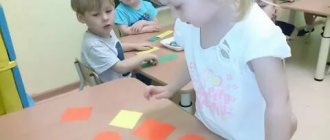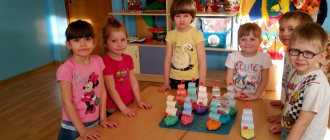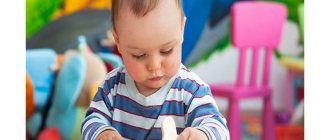Presentation of project activities with children of the first group of early age
Project activities in the first early age group
The project method was developed at the beginning of the twentieth century by the American philosopher, psychologist and educator John Dewey (1859-1952). According to D. Dewey, education should be based
“on an active basis through the appropriate activities of children in accordance with their personal interests and personal goals.”
Research activities bring the child:
- joy, providing a positive moral influence, - harmoniously develops the mental and physical abilities of a growing person.
The organization of such activities is carried out using modern technology: the project method.
The main goal
of the project method in preschool institutions
is: The development of the free creative personality of the child, which is determined by the developmental tasks and tasks of children's research activities.
Development objectives:
—
ensuring the psychological well-being and health of children;
— development of cognitive abilities; — development of creative imagination; — development of creative thinking; — development of communication skills
The starting point of the study is the children's interests of today
The role of the teacher when using the project method:
—
taking into account the age characteristics of children; — creating conditions to stimulate children’s interests; - building your relationship with your child on complicity and co-creation; - motivates children’s activities; - uses gaming methods and techniques. The role of the preschooler: - is an active participant in the project; — overcomes difficulties in solving problems (the leading didactic goal of project methods)
The project plan
is developed jointly with children and parents, social partners are involved, and a project team is selected.
After the project is defended, its implementation begins
Project implementation principles:
— systemicity, — seasonality, — taking into account the individual, — taking into account age characteristics, — interaction with the child in preschool and family settings
When using the project method, a number of requirements must be taken into account:
-1st, the result towards which the project is focused must be practically and educationally significant for its participants. - 2nd, the problem posed must be investigated in a certain logical sequence: putting forward hypotheses about ways to solve it; discussion and selection of research methods; collection, analysis and systematization of received data; summing up and preparing them; conclusions and raising new problems. - 3rd; the content of the project should be based on the independent activities of children planned by them at the preparatory stage of work.
Using the project method, the teacher becomes an organizer of children's research activities and a generator of the development of their creative potential.
stages
:
- goal setting; — search for a form of project implementation; — development of the content of the entire educational process based on the topic of the project; — organization of a developmental, cognitive, subject environment;
— determination of directions of search and practical activities;
— organization of joint (with teachers, parents and children) creative, exploratory and practical activities; — work on parts of the project, correction; — collective implementation of the project, its demonstration.
An approximate work plan
for a teacher to prepare a project:
- Setting the goal of the project. — Development of a plan for moving towards the goal (the teacher and methodologist discuss the plan with the parents). — Involvement of specialists in the implementation of relevant sections of the project. — Drawing up a project plan. — Collection, accumulation of material. — Inclusion of classes, games and other types of children’s activities in the project plan. — Homework and assignments for independent completion. — Presentation of the project, open lesson.
Classification of projects used in the work of preschool institutions
Currently, projects are classified:
a) by the composition of participants; b) according to the target setting; c) by topic; d) according to implementation deadlines.
By duration, projects can be:
- short-term (from 1 day to 1 month)
- long-term (from 6 months to 12 months)
Project on sensory development of children.
"Color Mosaic"
Target:
-
accumulation of sensory representations, including familiarization with color ;
— inclusion, whenever possible, of the main varieties of these properties
;
—
interaction with parents in teaching the sensory development of children in
the younger group
;
Tasks:
— to form children’s interest and ability to play sensory board games;
— to form a full-fledged perception of the surrounding world;
— to form the ability to examine objects, highlighting their color;
— to reveal the creative abilities of parents in productive and labor activities;
- and to activate the activities of parents in the process of teaching sensory standards.
Project participants:
- educators,
- children of the second early age group No. 3 “Fidgets”,
- parents.
WAYS TO IMPLEMENT THE PROJECT
-Examination of paintings: “Harvesting in the garden”; “What grows in the garden?”
- Drawing: “Rays for the sun”, “Leaf fall”, “Rain drip-drip”.
- Construction: “Cars drive along the track.” 1
- Modeling: “Carrot for a bunny.”
— Speech development: “Cockerel - cockerel.”
- Didactic game: “Collect balls in a basket.”
- Consultation for parents: “Sensory abilities for young children.”
— At the end of the project, there was entertainment: “Multi-colored balls.”
— Presentation of the project.
EXPECTED RESULTS:
— During the project, conditions were created to ensure the effective use of didactic games, didactic games were tested;
— Children learned to navigate colors;
- Find your bearings in contrasting values;
— Children’s level of knowledge on sensory development has increased;
— Parents received methodological recommendations on the sensory development of young children and how to play games with children.
Project on speech development for young children:
“Playing a game will help me speak faster.”
Target:
Develop children's speech as a means of communication; understand the speech of adults and peers using toys, books and games; learn to express your thoughts and requests in simple sentences. Develop children’s skills, following verbal instructions, to find objects by name, color, size; imitate the actions of people and the movements of animals.
Exercise children to clearly pronounce sounds in words during onomatopoeia; encourage children to use nouns, adjectives, verbs, and adverbs in independent speech. Strengthen children's ability to use prepositions in speech. Help children, while playing, dramatize passages from familiar fairy tales, nursery rhymes, songs, acting according to the rules.
Develop the ability to play in a team, address each other by name, using polite words, words of gratitude. Instill a love of fiction, art, games and toys.
Tasks :
- to form the development of active speech;
- purposefully enrich children's vocabulary;
- children’s needs to communicate with adults and peers through speech;
- understand the speech of others without visual accompaniment;
— the ability to understand works of Russian poetic folklore and works of fiction;
- support children’s cognitive attitude towards the surrounding reality (support the child in what he examines and observes);
- encourage children to engage in a variety of activities with objects aimed at familiarizing themselves with them;
- developing the ability to name objects in the immediate environment in the natural environment and in pictures; recognize and name people of different genders and ages;
- to teach you to understand the speech of others without visual accompaniment.
Project participants:
- educators,
- children of the second early age group No. 3 “Fidgets”,
- parents.
WAYS TO IMPLEMENT THE PROJECT
— Didactic games. – Plot-based role-playing games. - Outdoor games. – Theatrical activities: dramatization of fairy tales. – Fiction: reading and memorizing nursery rhymes. – Reading Russian folk tales. – Consultations, reminders.
EXPECTED RESULTS:
-The norm in the development of active speech is 80%; lag - 20%;
-We pay great attention to the organization of a subject-development environment.
— We create conditions for conducting didactic games.
— The group designed the spatial environment in such a way as to provide space for all types of sensory development, fine motor skills, imagination, and active speech.
-Game and didactic material is located in the child’s field of vision.
— Knowledge about the size, shape, color of objects was consolidated, memory, attention, tactile sensations, and fine motor skills were developed thanks to games with didactic material. — Children’s cognitive speech activity develops through direct educational activities;
— Dramatizations using toys; looking at pictures; acquaintance with works of fiction.
— As a result of systematic work on speech development, we have achieved positive results on this topic; children understand speech well, answer questions from adults, and enter into verbal contacts with teachers and loved ones. Children play collectively, develop plots, actively get involved in the game and begin to finish the text of the game, nursery rhymes, and fairy tales. Many people tell them on their own, try to dramatize fairy tales, and love to read and look at book illustrations.
— When talking with children, we recall familiar episodes and situations and encourage them to speak out. We support children’s desire to speak and communicate with each other, encouraging them to verbally express requests addressed to their peers.
Project of decorative design of the site
"A Tale in a Flowerbed"
Target:
Design landscape design for landscaping and decorative design of the site; landscaping and decoration with small fairy-tale forms.
Tasks:
—
Develop artistic and aesthetic taste, love for the nature of the native land.
— Develop a caring attitude towards the results of collective work.
— To promote the involvement of children and parents in active creative activities, strengthening child-adult relationships.
— Develop communication skills; feelings of love for kindergarten.
- Maintain joy and pleasure from flower arrangements; small forms of structures.
WAYS TO IMPLEMENT THE PROJECT
They were able...
Conversation on the topic: “Nature and children.”
Examination of illustrations for fairy tales; illustrations of flowers.
Reading fiction.
Observation of flowers.
Learning and reading poems about flowers.
Telling fairy tales located in the flowerbed.
Didactic games: “Flower meadow”, “Fold the flower”, etc.
Caring for flowers.
Working with parents:
Consultation on the topic: “The role of folklore in the formation of a careful attitude towards nature.”
Consultation on the topic: “Teach your child to love wildlife.”
Consultation: “Child and nature.”
Memo: “Introducing children to nature.”
Memo: “Cultivating love for one’s native land”
EXPECTED RESULTS
— Children’s knowledge of the plant world has been expanded.
-Increased love for the world around us through a fairy tale.
— Developed interest in the beautiful, colorful world of plants.
— Develop a caring attitude towards nature.
Research and experimental work project
"Wonders of nature"
Target:
Study of the properties and characteristics of sand and water; their ability to work with children; preserving and strengthening the psychological and mental health of children through the introduction of elements of play with sand and water.
Increasing the professional competence of a teacher as an organizer of various types of children's activities.
Tasks:
When working with children:
- development of children's independence and initiative; - instilling in each child a sense of self-worth, developing a desire for active activity; — creating a positive emotional mood, developing the ability to complete work; — development of cognitive processes (thinking, memory, attention, imagination)
- developing the ability to build compositions on the sand according to a model;
— prevention of children's conflicts and aggressive behavior.
Working with a teacher
:
- increasing the level of professional knowledge and skills;
— development of the teacher’s creative potential.
WAYS TO IMPLEMENT THE PROJECT
— Play exercises with water and sand. – Experiments with water and sand.
EXPECTED RESULTS
— Improve personal relationships between children;
— Generate interest in research activities. — Acquisition of experience by the teacher in independent selection of theoretical and research activities, evaluation of the results obtained.
Project
"Zimushka - winter"
Objective of the project:
- create conditions for the development of children’s cognitive, research and creative abilities during the development of the project.
- consolidate children's knowledge about the season - winter and its signs.
Disguise
- Develop the ability to answer the teacher’s questions, use adjectives and verbs in speech, learn to coordinate nouns and pronouns with verbs, use verbs in the future and past tense, practice using question words (who?, what?, where?) and simple phrases.
- - Encourage children to try to talk on their own initiative about what is depicted in the picture.
"Lamb"
- Develop speech breathing.
- Continue to develop fine motor skills of your fingers through finger games.
- Develop children's motor activity, teach them to perform movements that correspond to the text.
- — Awaken aesthetic feelings, cultivate interest in the arts.
Tasks:
1. Expand and deepen children’s knowledge about winter: weather conditions, typical precipitation, life characteristics of people, wild animals and birds in winter.
2. To promote a caring attitude towards nature, a desire to take care of birds and animals (make feeders, feed birds and animals).
3. Develop children's observation, cognitive activity, creativity, imagination, ability to notice changes in nature, and communication skills.
"Special" children in modern conditions"
4. Develop children’s productive activities, improve skills in drawing, modeling, appliqué, and develop creative abilities.
5. Promote the formation of cooperation in parent-child relationships.
"Good in a Circle"
Conditions for successful project implementation:
— Development of project activities taking into account the age characteristics of children.
- Introducing children to the ability to see and hear nature.
— Creating conditions for creative activity within the framework of the project for children, parents, and teachers.
— Implementation of close interaction between parents, teachers and children.
Expected Result:
— Expanding children’s horizons and consolidating their knowledge about seasonal changes in nature in winter;
— Development of children's creative abilities;
— Development of children's memory by memorizing poems about winter.
— Replenishment of the card index of winter-oriented games (didactic, mobile, finger games, and their use by children in free activities);
— Design of a group room and exhibition stand on the theme “Winter”;
— Involving parents in creative work with children, strengthening interest in cooperation with the kindergarten.





